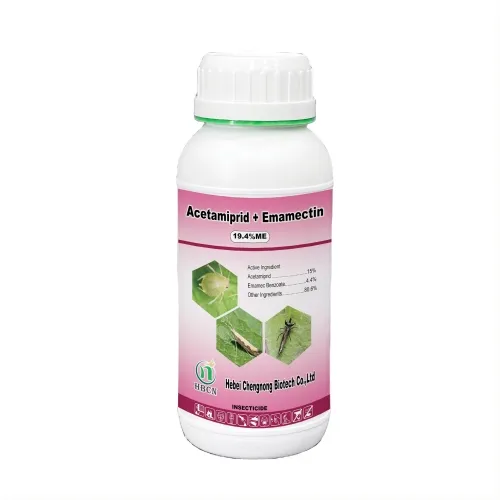
Nov . 12, 2024 08:36 Back to list
china thiamethoxam abamectin sulfoxaflor
Exploring the Use of Thiamethoxam, Abamectin, and Sulfoxaflor in Chinese Agriculture
In the dynamic landscape of modern agriculture, the need to enhance crop yields while ensuring pest control is increasingly critical. Among the various solutions, the introduction of systemic insecticides has become a focal point for farmers across China. Two of the prominent insecticides in this category are Thiamethoxam and Sulfoxaflor, along with Abamectin, which has shown efficacy against a wide range of agricultural pests. This article seeks to explore the roles these chemicals play in Chinese agriculture, their applications, benefits, and potential challenges.
Thiamethoxam A Neonicotinoid Insecticide
Thiamethoxam, a member of the neonicotinoid class of insecticides, is widely used in China due to its effectiveness in controlling sucking pests such as aphids, whiteflies, and planthoppers. Its systemic nature allows it to be absorbed by plants, providing long-lasting protection from pest infestations. Farmers appreciate Thiamethoxam for its rapid action; it targets the nervous system of insects, leading to quick knockdown and ultimately, pest mortality.
However, the use of Thiamethoxam has not been without controversy. Concerns over the environmental impact and potential risks to pollinators, particularly honeybees, have led to increased scrutiny and regulatory calls for responsible usage. In response to such challenges, researchers and policymakers have been encouraging integrated pest management (IPM) strategies, which emphasize the combined use of chemical and non-chemical control methods.
Abamectin A Versatile Biopesticide
Abamectin is a naturally derived insecticide produced from the fermentation of the soil bacterium *Streptomyces avermitilis*. Unlike synthetic counterparts, Abamectin is known for its wide spectrum of activity, effectively targeting mites, aphids, and other pests while having a relatively low toxicity to beneficial insects when applied correctly. In Chinese agriculture, Abamectin plays a crucial role in managing pests in various crops, including vegetables and fruit trees.
china thiamethoxam abamectin sulfoxaflor

Farmers benefit from Abamectin’s versatility and its minimal impact on the environment when used within recommended guidelines. Its mode of action involves targeting the insect’s nervous system, similar to Thiamethoxam, but it acts through a different mechanism, thus providing an alternative for resistance management. Continuous research is being conducted to further understand its environmental fate and refine application techniques to maximize efficacy while minimizing risks.
Sulfoxaflor An Emerging Solution
Sulfoxaflor, a newer class of insecticide known as sulfoximines, has gained traction in China for its effectiveness against sap-sucking pests. Similar to Thiamethoxam, Sulfoxaflor acts on the nicotinic acetylcholine receptors of insects, providing rapid control of pests such as aphids and whiteflies that pose significant threats to crop health. One of the key advantages of Sulfoxaflor is its reduced toxicity to many beneficial insect species, making it a more environmentally friendly option when used judiciously.
As with any chemical pesticide, the emergence of resistance is a significant concern. Therefore, it is imperative for farmers to implement resistance management strategies, including alternating between different classes of insecticides and integrating biological control methods to preserve their effectiveness in the long run.
Conclusion
Thiamethoxam, Abamectin, and Sulfoxaflor are vital components in the arsenal of tools available to Chinese farmers for effective pest management. While they each have their unique advantages, awareness of their environmental impact and resistance issues is crucial. As agriculture continues to evolve, fostering sustainable practices through integrated pest management and responsible chemical use will be essential for maintaining productivity while safeguarding the environment and non-target organisms. By embracing these strategies, the future of Chinese agriculture can thrive amid the challenges of pest control and sustainability.
-
Insecticide Spirotetramat 11% + Thiacloprid 11% SC at Good Price
NewsJul.30,2025
-
Best Abamectin SDS - Premium Quality & Reliable Safety Data
NewsJul.29,2025
-
Agrochemicals Pesticides Solutions for Sustainable Farming
NewsJul.29,2025
-
High-Quality Tebuconazole Fungicide for Crop Protection at Best Price
NewsJul.29,2025
-
Chlorfenapyr 8% + Clothianidin 20%SC Pesticide Mixture for Effective Pest Control
NewsJul.28,2025
-
Best Azoxystrobin Difenoconazole Supplier for Crop Protection
NewsJul.28,2025
